Army Vehicles
Overview
United States Army vehicles are a collection of awesome machines that transport soldiers and their weapons, cargo or systems. You’ll find them throughout the various units of the Army and utilized by among the different Army branches. On this page, we’ll cover the 21 army vehicles that are currently in service as of now. Ultimately, the army has some awesome and unique vehicles that cover virtually every need there is regarding their transportation needs. If the Army doesn’t have it, the need will be supplied by either the United States Air Force (by air) or by the United States Navy (by sea).
Unknown to many, the Army actually fields vehicles that can operate in all three physical environments (land, air, and sea). The reason for this is that the Army is the military’s premier land force and that it what it is known for. Additionally, Army air and sea vehicles are designed for limited capabilities within those environments.
Army Vehicles, in their primary role, typically fall into one of three categories; Maneuver (Tanks and Fighting Vehicles), Support (Support Vehicles), and Aerial (Aircraft).

Maneuver
Maneuver vehicles are armed combat vehicles protected by armor that combine operational mobility with offensive and defensive capabilities. Some of these vehicles are wheeled while others are tracked. This category includes the Army’s main battle tank, its’ fighting vehicles, as well as armored personnel carriers. Maneuver vehicles are used to directly engage the enemy in ground combat, deliver infantry troops of all ranks and to the frontline, or to do both.
Support
Support vehicles come in a multitude of configurations and are used, primarily, in roles that support maneuver units by providing fire support, operational assistance, and logistical support. They allow for providing a host of crucial functions like supply, maintenance, transportation, health services, and other services required by the soldiers of combat units to continue their missions in combat.
Aerial
Army aircraft consist of helicopters, fixed wing aircraft, and drones. With a variety of capabilities, these aircraft are used to transport soldiers and equipment, engage the enemy with direct fire, and to conduct observation operations. The Army also employs Unmanned Aerial Systems (drones) to support tactical, operational, and strategic operations. Essentially, drones are aircraft without a human pilot on board and capable of both observation and delivering strike payloads to the battlefield.

Army Tanks and Fighting Vehicles
When the United States Army’s ground forces engage the enemy in land warfare, they are backed up with the firepower needed to help them win. With the deadliest and most heavily armored tank on the planet and armored vehicles that bring combat soldiers to the fight, U.S. forces can confidently advance and defend objectives. Tanks and Fighting Vehicles provide overwhelming firepower while protecting soldiers from a multitude of battlefield hazards.
Abrams
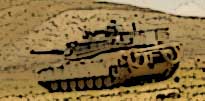 The M1 Abrams is the United States Army’s main battle tank. It is especially suited to dominate the battlefield in modern armored ground warfare. The Abrams is one of the heaviest tanks in service in the world. Its powered by mult-ifuel turbine engine making it capable of burning multiple types of fuel as required. It is heavily protected with a composite armor that is extremely difficult to penetrate. Additional features include a computer fire control system, a separate ammunition storage in a blow-out compartment, and protection against nuclear, biological, and chemical attack. Currently, the Abrams while later variants features a Rheinmetall 120 mm L/44 main gun.
The M1 Abrams is the United States Army’s main battle tank. It is especially suited to dominate the battlefield in modern armored ground warfare. The Abrams is one of the heaviest tanks in service in the world. Its powered by mult-ifuel turbine engine making it capable of burning multiple types of fuel as required. It is heavily protected with a composite armor that is extremely difficult to penetrate. Additional features include a computer fire control system, a separate ammunition storage in a blow-out compartment, and protection against nuclear, biological, and chemical attack. Currently, the Abrams while later variants features a Rheinmetall 120 mm L/44 main gun.
Bradley
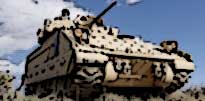 The Bradley Fighting Vehicle is designed to transport infantry or scouts with armor protection, while providing covering fire to suppress enemy troops and armored vehicles. There are several different versions, each of them is especially suited to a specific type of mission. There are three primary crewmembers of the Bradley; a commander, a gunner, and a driver. The number of additional personnel varies based on the configuration. The Bradley is capable of engaging and destroying troops, trucks, armored vehicles, and even some aircraft. Armament typically includes a 25mm chain gun, a 7.62mm coaxial machine gun, and TOW missiles.
The Bradley Fighting Vehicle is designed to transport infantry or scouts with armor protection, while providing covering fire to suppress enemy troops and armored vehicles. There are several different versions, each of them is especially suited to a specific type of mission. There are three primary crewmembers of the Bradley; a commander, a gunner, and a driver. The number of additional personnel varies based on the configuration. The Bradley is capable of engaging and destroying troops, trucks, armored vehicles, and even some aircraft. Armament typically includes a 25mm chain gun, a 7.62mm coaxial machine gun, and TOW missiles.
Cougar

The Cougar is an Mine-Resistant Ambush Protected vehicle. Referred to as an infantry mobility vehicle, the Cougar is a wheeled armored personnel carrier and can serve as a military patrol, reconnaissance, or security vehicle. It is protected against small arms fire, land mines and improvised explosive devices through the use of a combination of design features and hardened materials. Because of this high-tech combination, the Cougar’s crew and engine compartments are well protected against a wide range of attacks. The hull has a V shape that directs blasts away from the body of the vehicle. It also has dual air-conditioners to help keep heavily dressed troops from overheating in temperatures over 100 °F (38 °C).
Stryker
 The Stryker is an Infantry Carrier Vehicle (ICV) and a family of eight-wheeled armored fighting vehicles. It has 4-wheel drive (8×4) and, when needed, can be switched to all-wheel drive (8×8). The Stryker’s hull is made from high-hardness steel which can be bolstered with bolt-on ceramic armor which, together, offers all-around protection against 14.5 mm, armor-piercing ammunition, and artillery fragments from 155mm rounds. With some exceptions, the primary armament of the Stryker is a Protector M151 Remote Weapon Station with .50 in (12.7 mm) machine gun. They can also feature a 7.62 mm M240B machine gun, or 40 mm Mk 19 grenade launcher.
The Stryker is an Infantry Carrier Vehicle (ICV) and a family of eight-wheeled armored fighting vehicles. It has 4-wheel drive (8×4) and, when needed, can be switched to all-wheel drive (8×8). The Stryker’s hull is made from high-hardness steel which can be bolstered with bolt-on ceramic armor which, together, offers all-around protection against 14.5 mm, armor-piercing ammunition, and artillery fragments from 155mm rounds. With some exceptions, the primary armament of the Stryker is a Protector M151 Remote Weapon Station with .50 in (12.7 mm) machine gun. They can also feature a 7.62 mm M240B machine gun, or 40 mm Mk 19 grenade launcher.
Guardian
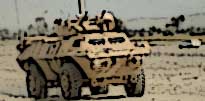
The M1117 Guardian is what is known as an Armored Security Vehicle (ASV). It fills the role of an internal security vehicle. The Guardian has a mine-resistant hull which helps to provide protection against improvised explosive devices.
It weighs in at around 15 tons making it lighter than both the Stryker and the Bradley Fighting Vehicle and can reach a speed of 20 miles per hour in 7 seconds. It is typically armed with an Mk 19 grenade launcher and M2HB Browning machine gun which are mounted in the turret. Additionally, the crew has 360° visibility when the Guardian is buttoned up.
M-ATV
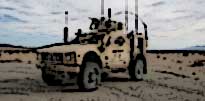 The M-ATV is a Mine Resistant Ambush Protected vehicle that was produced with the intent to replace the HUMVEE in front line action. It has a V-shaped hull and a coil sprung suspension that is completely independent. The hull also protects it from small arms fire. Run-flat tires and a central tire inflation system allow the M-ATV to keep moving at 30 mph for at least 30 miles even if two of the four tires lose pressure. There is also a traction control system along with anti-lock brakes.
The M-ATV is a Mine Resistant Ambush Protected vehicle that was produced with the intent to replace the HUMVEE in front line action. It has a V-shaped hull and a coil sprung suspension that is completely independent. The hull also protects it from small arms fire. Run-flat tires and a central tire inflation system allow the M-ATV to keep moving at 30 mph for at least 30 miles even if two of the four tires lose pressure. There is also a traction control system along with anti-lock brakes.
The M-ATV armament is roof-mounted and can be either manually or remotely operated. Some of the options include a M240 machine gun, a Mk 19 grenade launcher, an M2 Browning machine gun, a MILAN anti-tank guided missile, or a BGM-71 TOW anti-tank guided missile launcher.
Nyala
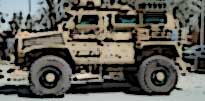
The RG-31 Nyala is a 4×4 multi-purpose vehicle. It is “mine-resistant and ambush protected infantry mobility vehicle”. In addition to the United States Army, the Nyala is the multi-purpose vehicle of choice of the UN and other peacekeeping and security forces. The V-shaped all-steel hull along with high suspension provide great protection against small-arms fire and mine blasts.
The Nyala is designed to resist a blast that is equivalent to two TM-57 anti-tank mines detonating at the same time. Depending on the configuration, it can carry a crew of 8 or 10, including the driver. The crew can dismount through a large rear door and two front doors.

Army Support Vehicles
The United States Army’s fleet of support vehicles do the heavy lifting and facilitate the movement of troops and equipment to and from the battlefield. Through the use of a variety of configurations, these vehicles fill every ground transportation need. Additionally, some of them are especially suited to perform a specific and necessary support function.
FMTV
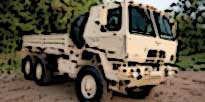
The FMTV or “Family of Medium Tactical Vehicles” is a series of vehicles and vary based on payload and mission requirements. Their primary role is that of troop and cargo transport.
There are also two cargo trailers that have payload capabilities that match that of the towing truck itself. These trailers also share a lot of the same components (including axles) with the towing truck allowing for increased part availability and mission readiness.
HEMTT
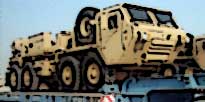 The HEMTT or “Heavy Expanded Mobility Tactical Truck” is the United States Army’s heavy tactical truck. It is an eight-wheel drive vehicle. Powered by a diesel engine and weighing 10-short-tons, it is favored by the US Army, other United States forces, and other countries. Its role is to provide heavy transport capabilities for supply and re-supply of combat vehicles and weapons systems. Compared to earlier generation 5-ton trucks in U.S. Army service it offers increased payload and mobility. Some of the uses of the HEMTT (based on configuration) include cargo transport, tanker, operations, and serving as a tractor and wrecker.
The HEMTT or “Heavy Expanded Mobility Tactical Truck” is the United States Army’s heavy tactical truck. It is an eight-wheel drive vehicle. Powered by a diesel engine and weighing 10-short-tons, it is favored by the US Army, other United States forces, and other countries. Its role is to provide heavy transport capabilities for supply and re-supply of combat vehicles and weapons systems. Compared to earlier generation 5-ton trucks in U.S. Army service it offers increased payload and mobility. Some of the uses of the HEMTT (based on configuration) include cargo transport, tanker, operations, and serving as a tractor and wrecker.
HUMVEE
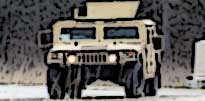 The HUMVEE or “High Mobility Multipurpose Wheeled Vehicle” is a family of light, four-wheel drive, military trucks and utility vehicles. It was designed primarily for personnel and light cargo transport behind front lines, not as a front line fighting vehicle. The basic HMMWV has no armor, although armor systems have been designed to provide limited protection. It seats four people and the body is constructed from lightweight and rust-resistant aluminum, instead of conventional steel. Armament may include a roof mounted machine gun or grenade launcher among others. At times, and due to limited options, the Army has used the HUMVEE as a platform for other weapon systems as well.
The HUMVEE or “High Mobility Multipurpose Wheeled Vehicle” is a family of light, four-wheel drive, military trucks and utility vehicles. It was designed primarily for personnel and light cargo transport behind front lines, not as a front line fighting vehicle. The basic HMMWV has no armor, although armor systems have been designed to provide limited protection. It seats four people and the body is constructed from lightweight and rust-resistant aluminum, instead of conventional steel. Armament may include a roof mounted machine gun or grenade launcher among others. At times, and due to limited options, the Army has used the HUMVEE as a platform for other weapon systems as well.
HET

The HET or “Heavy Equipment Transporter System” is the name of a United States Army logistics vehicle transport system. Its primary is to transport the M1 Abrams tank, Fighting Vehicles, and other heavy mobile platforms and equipment. HETs are also used to re-supply combat vehicles and weapons systems. By using the HET, the Army is able to conserve fuel and reduce the wear and tear on it heavy vehicles.
PLS
 The PLS or “Palletized Load System” is a truck-based logistics system. Its primary roles are to perform line haul (long distance), local haul (short distance), unit resupply, and other missions in the tactical environment to support modernized and highly mobile combat units. The HET provides the Army with the ability to rapidly move combat configured loads of ammunition and all classes of supply, shelters, and containers. The PLS has also been used to transport loose cargo and damaged vehicles between camps or to and from ports.
The PLS or “Palletized Load System” is a truck-based logistics system. Its primary roles are to perform line haul (long distance), local haul (short distance), unit resupply, and other missions in the tactical environment to support modernized and highly mobile combat units. The HET provides the Army with the ability to rapidly move combat configured loads of ammunition and all classes of supply, shelters, and containers. The PLS has also been used to transport loose cargo and damaged vehicles between camps or to and from ports.
Buffalo
 The Buffalo is a mine resistant ambush protected six-wheeled armored vehicle. It is equipped with a hydraulic arm from BAE Systems. It looks similar to but is larger than the Cougar. The “V” shaped monohull directs the force of the blasts away from the vehicle occupants. This vehicle combines ballistic and blast protection with infrared technology to detect the presence of dangerous ordnance. Soldiers inside operate the Buffalo’s 30-foot robotic arm and claw from within the armored hull via a mounted camera and sensory equipment, to safely dispose of the mines and IEDs. The Buffalo also has run-flat tires mounted on all six wheels.
The Buffalo is a mine resistant ambush protected six-wheeled armored vehicle. It is equipped with a hydraulic arm from BAE Systems. It looks similar to but is larger than the Cougar. The “V” shaped monohull directs the force of the blasts away from the vehicle occupants. This vehicle combines ballistic and blast protection with infrared technology to detect the presence of dangerous ordnance. Soldiers inside operate the Buffalo’s 30-foot robotic arm and claw from within the armored hull via a mounted camera and sensory equipment, to safely dispose of the mines and IEDs. The Buffalo also has run-flat tires mounted on all six wheels.

Army Aircraft
United States Army aircraft come in an array of fixed-wing aircraft, helicopters and unmanned aerial vehicles (drones). Each of these aircraft are capable of performing a variety of missions. Some of the Army’s piloted aircraft missions include assault, search and destroy, transport and supply, and recon. The Army’s drones are capable of performing strikes and reconnaissance without risking manpower. Piloted aircraft are usually piloted by warrant officers while the unmanned aircraft can be piloted by enlisted personnel.
Apache
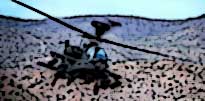 The AH-64 Apache is the United States Army’s primary assault helicopter. It is a twin-turboshaft attack helicopter with a four-blade main rotor, a four-blade tail rotor, and a tailwheel-type landing gear arrangement. It has a tandem cockpit for a crew of two.
The AH-64 Apache is the United States Army’s primary assault helicopter. It is a twin-turboshaft attack helicopter with a four-blade main rotor, a four-blade tail rotor, and a tailwheel-type landing gear arrangement. It has a tandem cockpit for a crew of two.
The Apache features a nose-mounted sensor suite for target acquisition and night vision systems. Armed with a 30 mm M230 chain gun and has four hardpoints mounted on stub-wing pylons for carrying armament and stores. Armament typically includes a mixture of AGM-114 Hellfire missiles and Hydra 70 rocket pods. Additionally, the crew compartment has shielding between the cockpits to increase the possibility of at least one crew member surviving hits.
Black Hawk
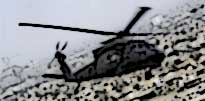
TheUH-60 Black Hawk is a four-blade, twin-engine, medium-lift utility helicopter. It is said to be one of the most versatile rotary aircraft in the world. Because of Its speed and high weight ceiling, it is suitable for multiple roles including; troop transport, sling load operations, and (properly equipped) combat operations.
The Black Hawk is capable of carrying 11 troops with equipment, lifting 2,600 pounds (1,200 kg) of cargo internally, or hoisting 9,000 pounds (4,100 kg) of cargo externally by sling. There are also special configurations used for electronic warfare and special operations.
Chinook
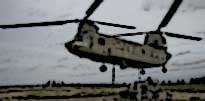 The Chinook is a heavy transport aircraft that is equipped to carry both troops and supplies. It has twin engines and a tandem rotor system and is among the heaviest lifting helicopters in the Western World. Armament can include up to 3 pintle-mounted medium machine guns (1 on loading ramp and 2 at shoulder windows and can be armed with the 7.62 mm M134 Minigun rotary machine gun.
The Chinook is a heavy transport aircraft that is equipped to carry both troops and supplies. It has twin engines and a tandem rotor system and is among the heaviest lifting helicopters in the Western World. Armament can include up to 3 pintle-mounted medium machine guns (1 on loading ramp and 2 at shoulder windows and can be armed with the 7.62 mm M134 Minigun rotary machine gun.
Lakota
 The UH-72 Lakota is a twin-engine light utility helicopter with a single, four-bladed main rotor. It is a militarized version of the Eurocopter EC145. The primary role of the Lakota is to perform logistics and support missions, disaster response missions, and medical evacuations. It is also often considered the best military aircraft in the United States military inventory for domestic operations.
The UH-72 Lakota is a twin-engine light utility helicopter with a single, four-bladed main rotor. It is a militarized version of the Eurocopter EC145. The primary role of the Lakota is to perform logistics and support missions, disaster response missions, and medical evacuations. It is also often considered the best military aircraft in the United States military inventory for domestic operations.
Little Bird
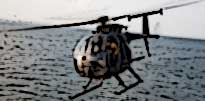 The MH-6 Little Bird is a light observation helicopter. It is commonly known as the “killer egg”. It is based on the MD 530F and has a single, six-bladed main rotor and a four-bladed tail rotor. Its roles include air interdiction, assault and light transport. The Little Bird armament can include a variety of weaponry including an M230 Chain Gun, Hydra 70 rocket pods and anti tank guided missiles. Its speed and maneuverability make it ideal for use in special operations.
The MH-6 Little Bird is a light observation helicopter. It is commonly known as the “killer egg”. It is based on the MD 530F and has a single, six-bladed main rotor and a four-bladed tail rotor. Its roles include air interdiction, assault and light transport. The Little Bird armament can include a variety of weaponry including an M230 Chain Gun, Hydra 70 rocket pods and anti tank guided missiles. Its speed and maneuverability make it ideal for use in special operations.
Huron
 The C-12 Huron is a fixed-wing, dual-engine aircraft. It role includes providing embassy support, medical evacuation, as well as passenger and light cargo transport. It is a proven workhorse, and serves as a personnel transport, and scout.
The C-12 Huron is a fixed-wing, dual-engine aircraft. It role includes providing embassy support, medical evacuation, as well as passenger and light cargo transport. It is a proven workhorse, and serves as a personnel transport, and scout.
Typically, the Huron has a one-person crew and a capacity to carry up to thirteen passengers. It weighs around 7760 lbs and its maximum take-off weight is 17,096 lbs. Its maximum speed is 310 mph with a range of almost 2,075 km and a service ceiling of over 35,000 ft. It can remain aloft for a maximum of five to six hours.
Gray Eagle
 The MQ-1C Gray Eagle is a medium-altitude, long-endurance unmanned aircraft system (Drone) . It is basically an upgrade to the MQ-1 Predator. It has a Diesel piston engine that burns jet fuel which gives it better performance at high altitudes. It can operate for 36 hours at altitudes up to 25,000 feet (7,600 m) and has an operating range of 200 nautical miles (400 km).
The MQ-1C Gray Eagle is a medium-altitude, long-endurance unmanned aircraft system (Drone) . It is basically an upgrade to the MQ-1 Predator. It has a Diesel piston engine that burns jet fuel which gives it better performance at high altitudes. It can operate for 36 hours at altitudes up to 25,000 feet (7,600 m) and has an operating range of 200 nautical miles (400 km).
The Gray Eagle’s nose fairing encases a synthetic aperture radar/ground moving target indicator system, and targeting is also provided with an AN/AAS-52 Multi-spectral Targeting System (MTS) under the nose. It can carry a payload of 800 pounds (360 kg) and may be armed with weapons such as AGM-114 Hellfire missiles and GBU-44/B Viper Strike guided bombs. Additionally, Its sensors can fuse infrared imagery and use the SAR to scan and detect changes in terrain like tire tracks, footprints, and buried improvised explosive devices.
Shadow 200

The RQ-7 Shadow is an unmanned aerial vehicle (Drone) used for reconnaissance, surveillance, target acquisition and battle damage assessment. It has a high-wing configuration with a twin-tail boom and an inverted v-tail.
It is launched from a trailer-mounted pneumatic catapult and recovered with the aid of arresting gear similar to those used on aircraft carriers to stop jets when they land. The Shadow’s gimbal-mounted, digitally stabilized, liquid nitrogen-cooled electro-optical/infrared camera relays video in real time via a C-band line-of-sight data link to a ground control station. The drone is operated in the United States Army at brigade level.
Summary
In summary, as the United States Military’s premier land force, the United States Army vehicles (in combination) cover virtually every land warfare need that soldiers may encounter on the modern-day battlefield. There is one or more capable of operating in all three physical environments (land, air, and sea). In their primary roles, the Army’s vehicles typically fall into one of three categories; Tanks and Fighting Vehicles, Support Vehicles, and Aerial Vehicles. Each plays their part in successfully meeting the Maneuver and Fire and Effects, Support, and Sustainment needs.